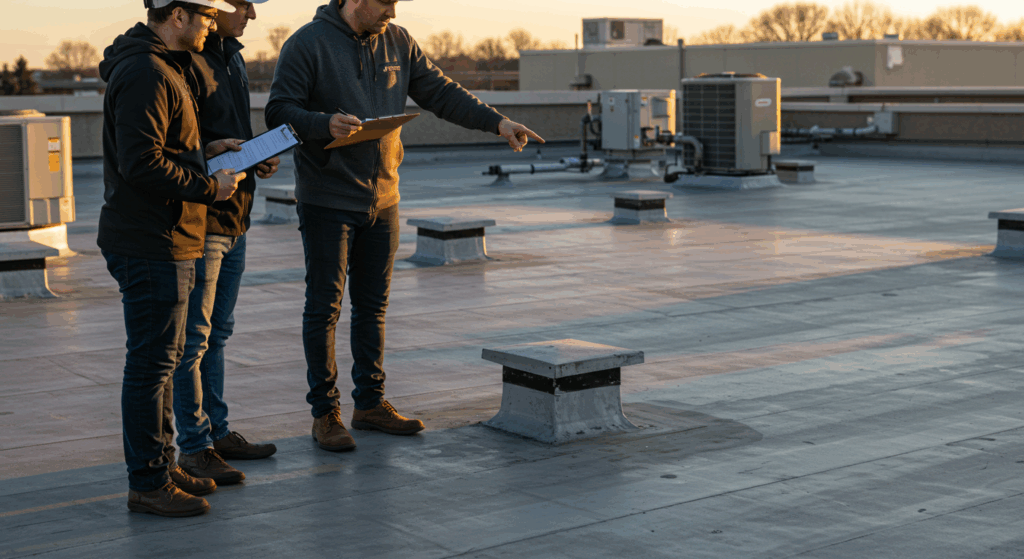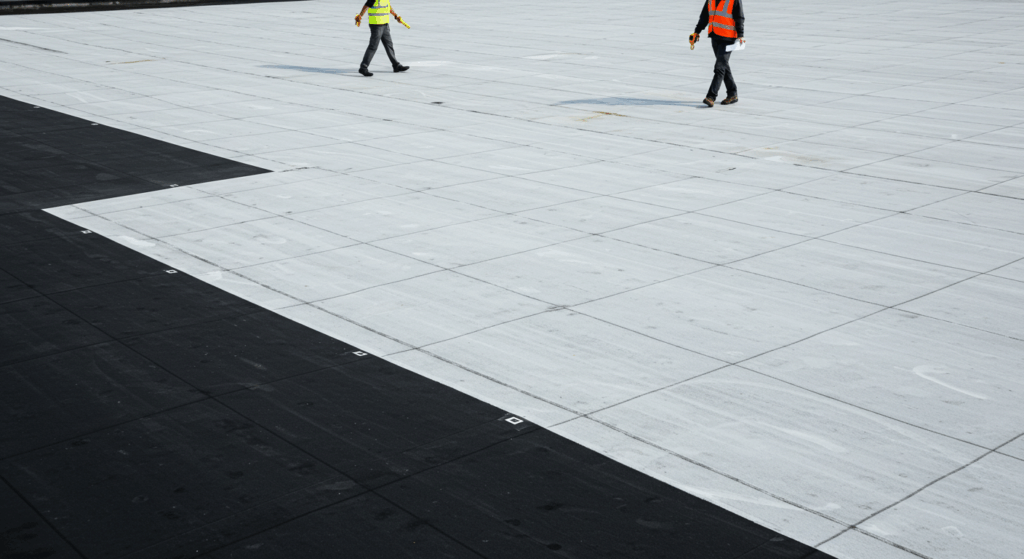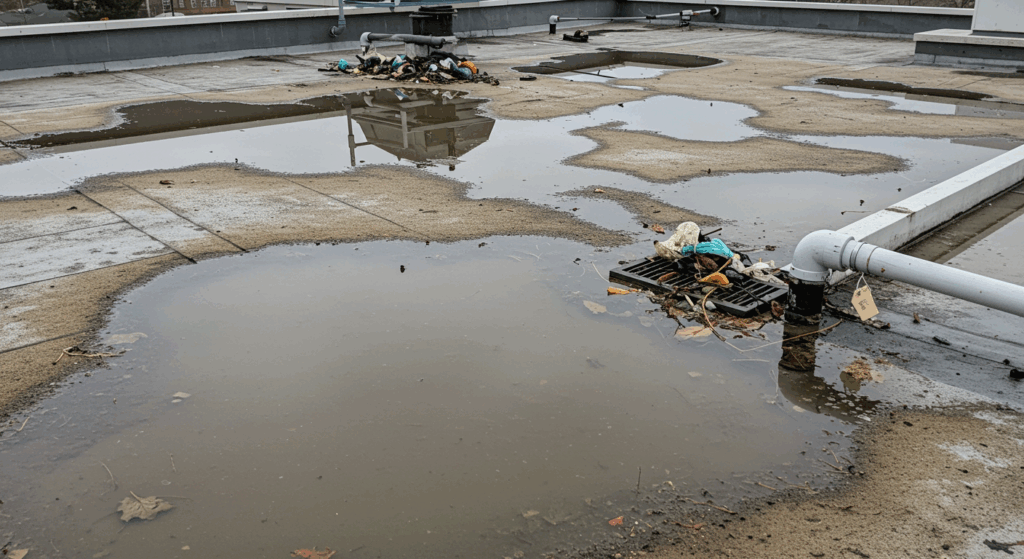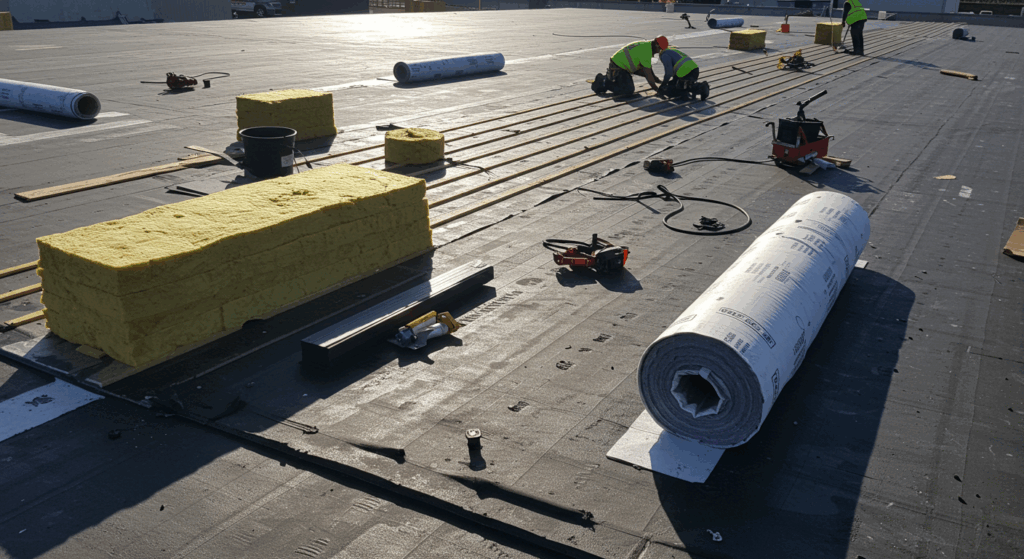Flat Roof Warranties: How Long They Last and What They Cover

When you invest in a flat roof system, understanding the warranty is essential to protect that investment. Many property owners miss important details in the fine print, only to face unexpected repair costs later. A solid warranty can prevent these surprises and help save thousands in long-term maintenance.
Flat roof warranties differ in length, coverage, and exclusions based on the materials, manufacturer, and contractor. Basic warranties may offer 10-15 years of material coverage, while premium systems can extend up to 30 years or more. Knowing what’s covered, what’s not, and how to stay compliant is key to keeping your warranty intact.
This guide covers the main types of flat roof warranties, common coverage timelines, typical inclusions and exclusions, and how to get the most value from your warranty. With insights from Premier Roofing, you’ll be equipped to make confident decisions and protect your roof investment.
Understand Flat Roof Warranty Options to Protect Your Investment
Understanding the different warranty types available for flat roofing systems helps property owners make informed decisions about their coverage options. Most flat roof warranties fall into three primary categories: manufacturer warranties, contractor warranties, and extended or system warranties.
Manufacturer warranties typically cover defects in roofing materials and are provided directly by the company that produces the roofing products. These warranties usually range from 10 to 30 years, depending on the material quality and manufacturer.
Premium manufacturers like GAF, Carlisle, and Firestone often provide longer warranty periods for their high-end membrane systems, while basic materials may only carry 10- to 15-year coverage. Contractor warranties, also known as workmanship warranties, cover installation-related issues and are provided by the roofing company that performs the work.
These warranties typically last 1-5 years and address problems arising from improper installation techniques, poor workmanship, or failure to follow manufacturer specifications. A reputable contractor will stand behind their work and provide comprehensive workmanship protection.
System warranties represent the most comprehensive coverage option, combining both material and workmanship protection under a single warranty document. These warranties are typically issued by the manufacturer but require certified installation by approved contractors.
System warranties often provide the longest coverage periods and most extensive protection, making them highly valuable for commercial properties and high-end residential installations.
Compare Roofing Materials by Warranty Length and Reliability

Different flat roofing materials offer varying warranty periods, reflecting their expected lifespan and performance characteristics. Single-ply membrane systems, including EPDM (ethylene propylene diene monomer), TPO (thermoplastic olefin), and PVC (polyvinyl chloride), typically carry manufacturer warranties ranging from 15 to 30 years.
EPDM rubber roofing systems often come with 20- to 25-year warranties, reflecting their proven durability and weather resistance. These synthetic rubber membranes have demonstrated excellent performance in various climate conditions, with many installations exceeding their warranty periods.
Quality EPDM systems installed by experienced contractors can often provide reliable service for 30-40 years with proper maintenance. TPO roofing warranties typically range from 15-20 years for standard products, with premium formulations offering up to 30-year coverage.
As a newer technology compared to EPDM, TPO warranties have evolved as manufacturers have refined their formulations and improved long-term performance data. The reflective properties of TPO membranes make them increasingly popular for energy-efficient building designs.
Built-up roofing (BUR) systems, consisting of multiple layers of bitumen and reinforcing fabrics, typically carry 10- to 20-year warranties. While BUR systems have a long history of reliable performance, their labor-intensive installation process and multiple components can create more potential failure points.
However, when properly installed and maintained, BUR systems often outlast their warranty periods significantly. Modified bitumen roofing systems generally offer 15- to 25-year warranties, depending on the specific product and installation method.
These systems combine the proven performance of traditional built-up roofing with modern polymer modifications, resulting in enhanced flexibility and durability.
Know What’s Covered in Your Flat Roof Warranty
Comprehensive flat roof warranties address several key areas that commonly affect roofing system performance and longevity. Material defects represent the primary coverage area for most manufacturer warranties, protecting against manufacturing flaws, premature deterioration, and failure to meet specified performance standards.
Membrane integrity issues, including splits, cracks, and premature aging, are typically covered under quality warranties. This coverage ensures that the roofing membrane maintains its waterproof barrier throughout the warranty period, provided proper installation and maintenance requirements are met. For commercial properties, this protection can prevent costly interior damage from water infiltration.
Installation-related problems fall under workmanship warranties, covering issues such as improper seaming, inadequate adhesion, incorrect flashing installation, and failure to follow manufacturer specifications.
A recent case study from 2023 involved a 50,000 square foot commercial building where poor seam installation led to multiple leaks within two years of installation. The contractor’s comprehensive workmanship warranty covered complete re-seaming of the affected areas at no cost to the building owner.
Ponding water issues may be addressed in certain warranties, particularly when related to inadequate slope or structural problems present at installation. However, coverage for ponding water varies significantly between manufacturers and often requires specific documentation of roof slope conditions at the time of installation.
Wind uplift resistance is another critical coverage area, especially for commercial flat roofs in high-wind regions. Quality warranties specify wind speed ratings and provide coverage for uplift-related damage when the roofing system is properly installed according to local wind load requirements.
Avoid Costly Surprises by Understanding Warranty Exclusions

Understanding warranty exclusions helps property owners avoid actions that could void their coverage and ensures realistic expectations about protection levels. Most flat roof warranties exclude damage caused by acts of nature, including hail, severe storms, hurricanes, and earthquakes. While the roofing system may be designed to withstand normal weather conditions, extreme events typically fall outside warranty coverage.
Maintenance-related exclusions represent a significant category that property owners must understand thoroughly. Failure to perform required maintenance, such as regular inspections, drain cleaning, and debris removal, can void warranty coverage entirely. Most manufacturers require annual professional inspections and documentation to maintain warranty validity.
Unauthorized modifications or repairs performed by non-certified contractors typically void warranty coverage immediately. This includes installing additional equipment, penetrations, or attachments without proper approval and installation by qualified professionals. Even minor repairs performed by unqualified personnel can jeopardize entire warranty coverage.
Ponding water exclusions are common in flat roof warranties, particularly when ponding results from structural settling, inadequate drainage design, or blocked drains. Many warranties specifically exclude coverage for areas where water stands for more than 48-72 hours after rainfall, emphasizing the importance of proper drainage system maintenance.
Normal wear and tear, including gradual deterioration from UV exposure, thermal cycling, and aging, typically falls outside warranty coverage. Warranties protect against premature failure and defects, but don’t guarantee indefinite performance beyond expected material lifespans.
Take Action to Extend the Value of Your Flat Roof Warranty
Proper documentation and compliance with warranty requirements are essential for maximizing protection and ensuring claims are honored when needed. Maintaining detailed installation records, including photos, material specifications, and contractor certifications, provides crucial evidence for potential warranty claims.
Regular professional inspections represent the most important step in maintaining warranty coverage and identifying potential issues before they become major problems. Most manufacturers require annual inspections by qualified roofing professionals, with detailed reports documenting roof condition and any maintenance performed.
Premier Roofing recommends establishing a comprehensive inspection schedule immediately after installation to ensure warranty compliance and optimal roof performance. Prompt repair of minor issues prevents small problems from developing into major warranty exclusions.
Addressing small membrane punctures, loose flashing, or minor seam separations quickly can prevent water infiltration and more extensive damage that might not be covered under warranty terms. Working exclusively with warranty-approved contractors for any repairs or modifications ensures continued coverage validity.
Many property owners unknowingly void their warranties by allowing unqualified contractors to perform even minor repairs. Always verify contractor certifications and obtain manufacturer approval before authorizing any roofing work.
Maintaining proper drainage is crucial for warranty compliance and roof performance. Regular cleaning of drains, gutters, and scuppers prevents water accumulation that could lead to warranty exclusions. Property owners should establish seasonal maintenance schedules to address drainage issues before they affect the roofing system’s performance.
Choose the Right Warranty Type for Better Long-Term Protection

System warranties offer the most comprehensive protection available for flat roofing installations, combining material and workmanship coverage under unified terms and conditions. These premium warranties typically require certified installation by manufacturer-approved contractors and often include additional components such as insulation, cover boards, and flashing systems.
The primary advantage of system warranties lies in their simplified claims process and comprehensive coverage scope. Rather than navigating separate claims with material manufacturers and installation contractors, property owners deal with a single warranty provider for all covered issues. This streamlined approach often results in faster resolution times and reduced administrative complexity.
System warranties frequently offer longer coverage periods than standard warranties, with many extending 20-30 years for complete roofing systems. Premium system warranties may include additional benefits such as guaranteed leak repairs, priority service response, and coverage for consequential damages in certain circumstances.
However, system warranties typically require higher upfront investment and more stringent maintenance requirements. The additional cost reflects the enhanced coverage and longer protection periods, making system warranties particularly valuable for commercial properties and critical facilities where roofing failure could result in significant business interruption costs.
A 2024 analysis of commercial roofing claims showed that properties with system warranties experienced 40% faster claim resolution times and 25% higher claim approval rates compared to standard warranty coverage. This data demonstrates the practical value of comprehensive warranty protection for commercial property owners.
Frequently Asked Questions
How long do most flat roof warranties last?
Most flat roof warranties range from 10 to 30 years, depending on the roofing material and warranty type. Standard manufacturer warranties typically provide 15-20 years of coverage, while premium system warranties can extend up to 30 years.
EPDM and PVC systems often carry warranties of 20 to 25 years, while TPO systems typically offer 15 to 20 years. The warranty duration usually reflects the expected lifespan and proven performance history of the specific roofing material.
What voids a flat roof warranty most commonly?
The most common warranty voiding actions include performing unauthorized repairs with non-certified contractors, failing to maintain required annual inspections, and neglecting basic maintenance requirements such as drain cleaning and debris removal.
Additionally, installing equipment or making penetrations without manufacturer approval, allowing ponding water conditions to persist, and failing to address minor issues promptly can void warranty coverage entirely.
Are leaks automatically covered under flat roof warranties?
Leaks are not automatically covered under all circumstances. Warranty coverage for leaks depends on the underlying cause and whether proper installation and maintenance requirements have been met.
Leaks caused by material defects or installation errors are typically covered, while leaks resulting from damage, poor maintenance, ponding water, or normal wear and tear may be excluded. Prompt reporting and professional assessment are crucial for leak-related warranty claims.
Do I need annual inspections to maintain my warranty?
Most flat roof warranties require annual professional inspections to maintain coverage validity. These inspections must typically be performed by certified roofing professionals and documented with detailed reports.
The inspection requirement ensures that potential issues are identified early and proper maintenance is performed throughout the warranty period. Premier Roofing emphasizes that consistent inspection schedules are essential for warranty compliance and long-term roof performance.
Can I transfer my flat roof warranty to a new property owner?
Many flat roof warranties are transferable to new property owners, but specific procedures and fees may apply. Warranty transfer typically requires notification to the manufacturer within a specified timeframe, payment of transfer fees ranging from $100 to $500, and verification that all maintenance requirements have been met.
Some warranties limit the number of transfers allowed or reduce coverage terms for subsequent owners. Review your specific warranty terms and contact the manufacturer to understand transfer procedures and requirements.
Plan Your Warranty Strategy with Trusted Roofing Support
Understanding flat roof warranties empowers property owners to make informed decisions that protect their roofing investments for decades. From basic 10-year material coverage to comprehensive 30-year system warranties, the right protection depends on your specific needs, budget, and risk tolerance.
Remember that warranty value extends far beyond the coverage period through proper maintenance compliance, documentation, and working with certified professionals for all roofing services. By following manufacturer requirements and maintaining detailed records, you can maximize your warranty benefits and ensure reliable roof performance throughout its intended lifespan.
About Premier Roofing
Premier Roofing brings over 15 years of experience in commercial and residential flat roofing, serving property owners across the region. We offer full-service solutions, including EPDM, TPO, modified bitumen, and built-up roofing systems. Our certified professionals pair technical skill with a deep understanding of warranty standards to ensure every installation delivers long-term protection.
We’re certified by leading manufacturers like GAF, Carlisle, and Firestone, which allows us to offer premium system warranties for added peace of mind. With more than 500 completed commercial flat roof projects, many exceeding their warranty lifespans, we know proper installation and maintenance are key to keeping coverage intact and performance strong.Contact our team today to discuss how our flat roofing expertise can help you select the right warranty protection for your property. Schedule a consultation to learn more about our certified installation services and how we’ve helped clients achieve maximum warranty value and long-term roof performance.
